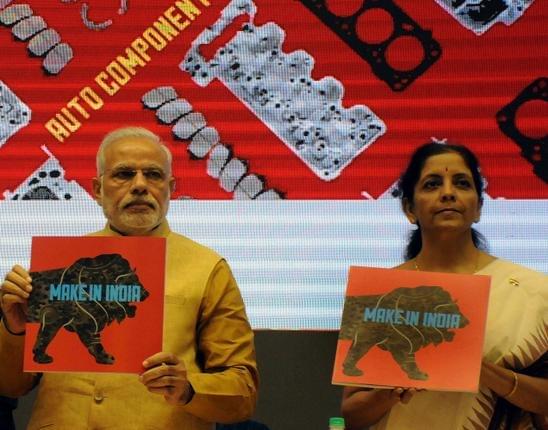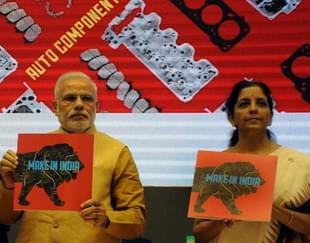Economy
Can Make in India Learn From Make It in Germany?
Rajendra Pratap Gupta
Jan 17, 2015, 04:41 PM | Updated Feb 18, 2016, 12:07 PM IST
Save & read from anywhere!
Bookmark stories for easy access on any device or the Swarajya app.


We need to look beyond big business houses and setting up of big automated manufacturing companies, and look at the SME sector for sustainable double-digit GDP growth.
The Indian economy has transitioned fast in the past six months, and is passing through an interesting and an important phase.
It was considered an Analyst Grade economy under the UPA regime. Investors kept analyzing, and, due to red tapism, corruption and an uncertain next term for the UPA regime, China and other countries became preferred destinations compared with India.
Under Prime Minister Modi, India has become an Interest Grade economy; with a wait and watch phase, where investors are looking with great interest at various options but with cautious optimism. Once the economy moves beyond this phase, it will move into an Investment Grade economy (where people are keen to invest) and finally, it will be a Consumption Grade economy (when the local population will have enough buying power for the goods produced in the country); and that is the final frontier that every investor is looking at .
But the big questions are: How do we get there? When do we get there? Are we doing enough to get there? Is ‘Make in India’ enough?
In the past seven months, we have seen the government’s focus on getting foreign investors to invest in India under the ‘Make in India’ programme. Is this enough to make India a Consumption Grade economy?

The combined wealth of the top six promoter families in India is approximately Rs 15 lakh crore. If we aggressively look at FII or FDI for lifting the economy, it will lead to concentration of wealth in a few hands, and maybe, create a few thousand jobs, but this falls woefully short of the need for this country’s employment needs; considering that even the largest private company in India does not employ more than 170,000 people (the next biggest employer comes at 100,000 and then, others fall much lower).
Needless to mention, all business houses are automating their operations, and are in the process of rationalizing their head counts. This means more people rendered jobless, as all these corporations look at ROI per employee (which isn’t wrong).
Manufacturing employs just about 50 million in India but nearly 12 million enter the job market every year, plus we add another about 50 million unemployed. So, do big business houses or setting up of automated big manufacturing companies offer the right solution? Not really! We need to go beyond Making in India.
German Mittelstand. Germany as a country has done well compared with others, and here comes an important lesson for India—German Mittelstand (SMEs in Germany). SMEs in Germany had the biggest contribution to high employment and productivity . Here are some interesting statistics, from the Federal Ministry of Economics and Technology, Germany:
1.More than 99% of all German firms ( 3.7 million ) belong to SMEs
2.SMEs contribute alomost 52% of the total economic output, totalling a turnover of Euro 2 trillion
3.SMEs employs 60% of employees subject to social security contributions and employ 83.2% of trainees
4.95% of Germany’s SMEs are family-owned
5.German SMEs are the most innovative in Europe and supply goods all over the world, and there are some 1,300 world market leaders from the German Mittelstand
6.They cover all sectors like electrical, engineering and industrial products.
7.SMEs are a major contributors to low youth unemployment than many European nations
8.The ‘Make it in Germany’ website is a supporter of the initiative
German Mittelstand has important lessons for India. So far, I haven’t seen any visible Indo-German cooperation agreements but only that with the US, Japan and China. We need to look at closer ties with Germany and seek its help for developing our Indian version of German Mittelstand.
We need Make in India and also a Make in Bharat push.India has many more opportunities than Germany. We have the world famous Khadi brand. Can KVIC not become a global franchise with varied offerings, and a launching pad for weavers, and sellers of ‘certified’ natural and organic produce—Made in Bharat? Indian organic crops can certainly command a global premium.
India has about 270 geographical indicators and we need SMEs to leverage the geographical indicators for creating businesses .
We have Nature’s wealth spread across every region of the country. Our goal should be to channelise the growth and contributions of agriculture , manufacturing and services sectors through SMEs for creating brands, wealth, entrepreneurs and jobs. There is so much to do in India.
We do not just need ‘ease of doing business’ for the big business houses, but, we also need the ease of doing small business, ease of doing business in ‘Bharat’, the real—rural India, where 65% of the country’s population lives. We need a dedicated SME bank, besides the Entrepreneurial fund, that offers capital at affordable rates. We need an enabling ecosystem to handhold micropreneurs, and India can realise the goal of double digit growth
IMF had said: “India’s young population has the potential to produce an additional 2% per capita GDP growth each year for the next two decades.” We need to fire the youth and SME engine to make India unstoppable.
Views expressed here are personal
Rajendra Pratap Gupta is a Member (Marketing) of the Khadi and Village Industries Commission.





